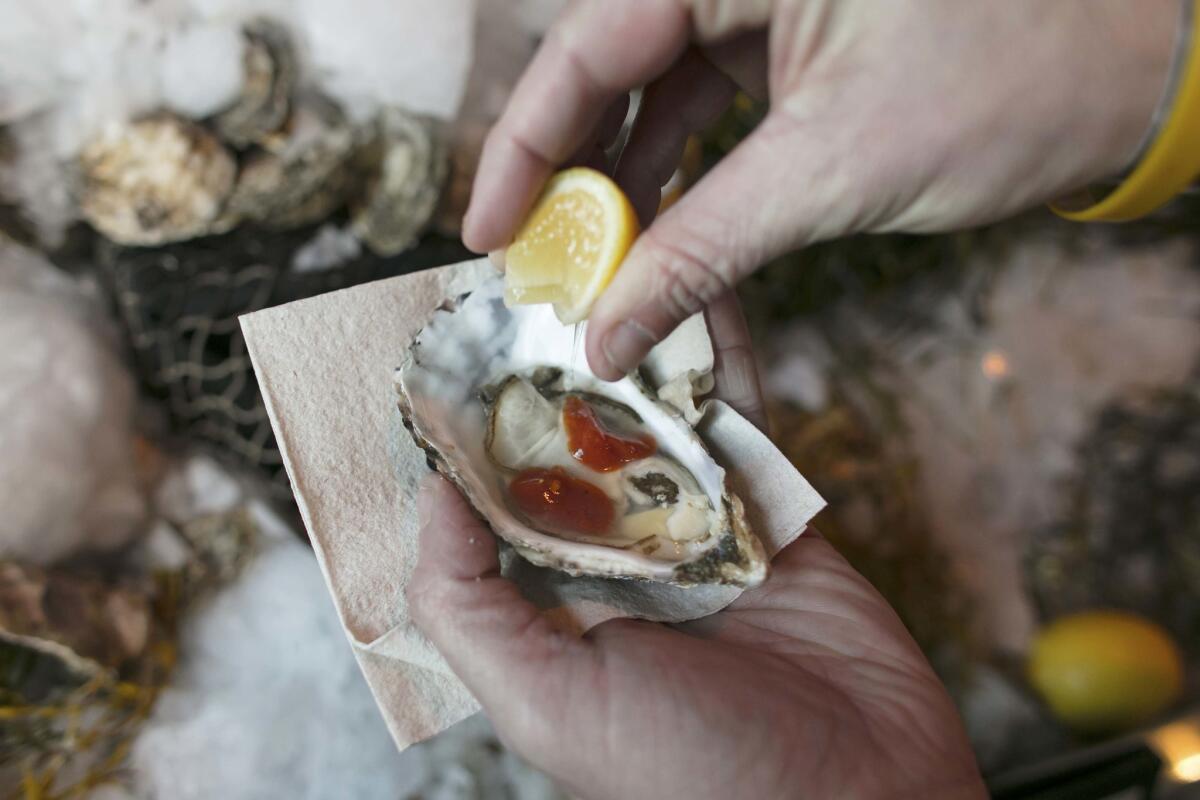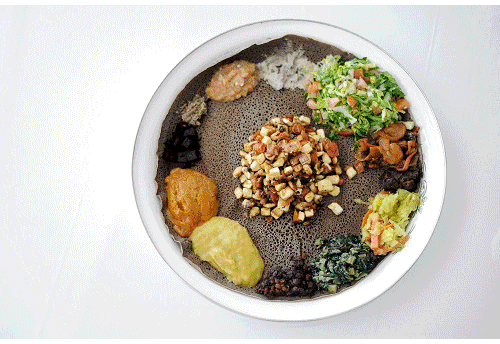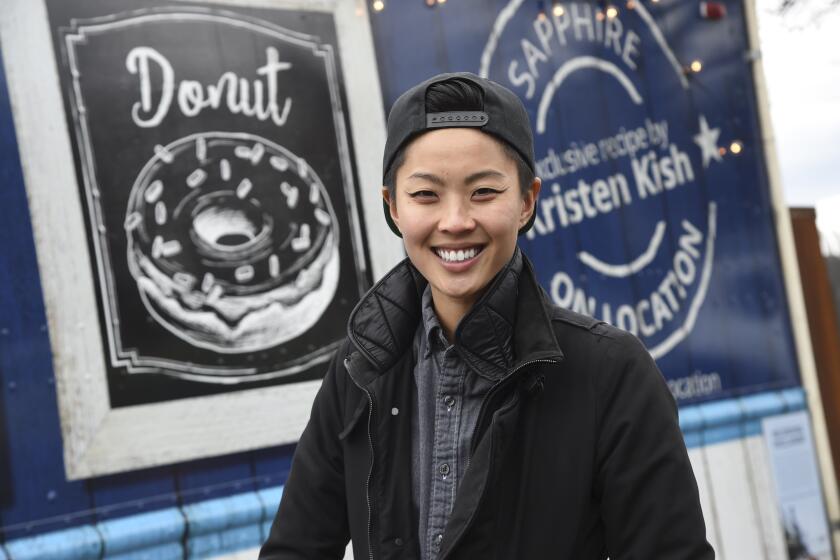Q&A: Love oysters? Here’s how to truly understand and appreciate these delicious bivalves

- Share via
It’s oyster season and prime time to enjoy these mysterious mollusks in all their glory. They prelude our meals, boost our libido and nourish our bodies, but so little is known about them — even to the seasoned diner. We talked to some chefs to help us break down the essentials:
Q: How can you tell an East Coast from a West Coast oyster?
East and West Coast oysters simply look different. Providence chef Michael Cimarusti explains: “East Coast oysters are consistent, clean-edged, and West Coast are much more wavy, with less regular edges, and often have a deeper shell.”
The oysters on each coast differ in terms of species. Only Crassostrea virginicas, the indigenous oyster, exists on the East Coast. On the West Coast you will find Crassostrea gigas, originally native to the Asian side of the Pacific but now the most widely raised oyster on this side; Crassostrea sikamea or Kumamotos from Japan; and the tiny Ostrea lurida, the only native West Coast oyster, in Washington.
Ryan Croxton, co-owner of Rappahannock Oyster Co., says: “The West Coast oyster flavor tends to taste like watermelon, which arises from the basic water chemistry of the Pacific Ocean.”

Ari Kolender, chef and partner of Found Oyster in East Hollywood, explains: “East Coast oysters tend to be a lot more briny and mineral-driven with a sweeter flavor. [With] West Coast oysters you get this kelpy flavor that comes from the merroir [see below] of kelp forests. It lends itself to have way more umami, in my opinion.”
Sometimes, especially to the novice, it’s hard to tell which is which purely by salinity. Christopher Tompkins, founder of Broad Street Oyster Co., grew up in New York but found West Coast oysters raised in Morro Bay on the Central Coast — specifically Pacific Golds and Grassy Bars — to appease his craving for that East Coast brininess.
Q: What are the variables that affect how oysters taste?
In “A Geography of Oysters,” author Rowan Jacobsen pushed the concept of “merroir” — an aquatic equivalent to terroir, the idea that the flavors of certain wines (and other terrestrial foods) channel the place they were made. “Oysters,” he wrote, “will vary in flavor and appearance through the course of a year, depending on water temperature, algae availability, spawning and other factors.”
Intertidal, beach-raised oysters that have had to intermittently struggle in the open sun will generally prove stronger and fuller than subtidal oysters. East Coast oysters are generally subtidal because exposure to open air would make them susceptible to icing; West Coast oysters are often intertidal but exceptions abound.
Eat your way across L.A.
Get our weekly Tasting Notes newsletter for reviews, news and more.
You may occasionally receive promotional content from the Los Angeles Times.
Freshwater, in an estuary or anywhere else there’s rainwater runoff, decreases water salinity and oyster brininess. Grassy notes come from oysters filter-feeding through algae in the water, and different kinds of algae come in waves throughout the season. “It’s easier to spot the differences in oysters that are not on the oceanside. Oceanside is always going to be salty,” says Croxton.
Oysters raised in strong, open ocean currents will have a lot of brine from the abundance of saltwater, whereas bottom-raised oysters will have a lot of earthy notes because of sediment. Upwelling in the oyster bed provides nutrition and oxygen while the colder temperature creates a firmer oyster.
That’s a lot of seaside lingo to digest; being familiar with it will help you keep up with a knowledgeable oyster person, the best resource to help you sort out which oysters will be to your liking — or to set you up with a selection that will enable you to taste distinct varieties so you can home in on what works for you.
Q: What does a good quality, well-shucked oyster look like?
The water fill inside the oyster should be clear and almost level with the shell; the meat ivory-colored, intact and supple with good flex. Oysters not in season will appear thinner and the water fill milky. The meat will be transparent if it has already spawned — not a quality or taste you want.
Q: What pairs well with oysters?
White wine with seafood is a rule that holds true, according to Christophe Happillon, owner of Oyster Gourmet in Grand Central Market. He recommends French varietals, such as Sancerre. “Wines with minerality go well with oysters. You don’t want something that’s aged too long that would interfere with the taste. Anything that is dry pairs well. Chenin Blanc and anything else not high in tannins are good.”
Luxury seafood from star chef Joshua Skenes at Angler in the Beverly Center.
Hope Ewing, general manager and beverage director of Rappahannock at the Row, likes to pair especially salty oysters like their Olde Salts with a martini. “My favorite thing to do is match like with like and eat them alongside a savory martini. In lieu of olive brine, which contains oils that coat your mouth, our version has Ford’s Gin, Carpano Dry vermouth and Bittermens celery shrub.”
Ewing says Fukucho Seaside Sparkling Sake pairs well with all oysters. “Made in the Champagne method with a secondary fermentation in the bottle, the Seaside Sparkling has the tight bubbles of a sparkling wine but the mild acid, subtle fruitiness and umami of a great sake,” she said.
Q: What would you say to someone who’s worried about getting sick from eating raw oysters?
Bad oysters exist, with norovirus and vibriosis being the most common pathogens.The majority of the raw oysters we consume are raised expressly for that purpose, and the waters they grow in are tested, making the scariest bacteria rare to encounter. (And, yes, oysters are “raised” on “farms” — though unlike much farm-raised seafood, shellfish aquaculture is almost unanimously regarded as not just environmentally neutral but beneficial to the waters it happens in.)
Before ordering, take a look at how the restaurant treats its seafood (Is there a staff member dedicated to tending the raw bar?) and how the shucked oysters appear. If you do get sick, be sure to visit your doctor right away, drink lots of water to replenish your dehydrated system and contact the restaurant and the health department so they can trace where the bacteria came from and track down the other oysters sourced from the same place.
Q: How should you enjoy an oyster?
There’s no wrong way to eat an oyster. However, to appreciate the nuanced differences between oysters, it’s best to try the first few without any distractions, a.k.a. condiments. After that, do what you like: lemon juice, mignonette, cocktail sauce, horseradish.
Rifko Meier owns New York catering company Oysters XO and introduces oysters to many first-timers. “I tell them, ‘Sip the water first.’ That’s ocean water and that’s the essence of the sea. That’s what the oyster is,” he says.
The official L.A. Times list of the 101 best restaurants in Los Angeles, curated by our restaurant critics.
While it’s tempting to knock them back or slurp them whole, take time to enjoy the oyster and really taste the nuances in each one. What kind of minerality does it have? Does it taste like melon or brine? When you chew, pay attention to the abductor muscle. “The abductor muscle lends a lot of sweetness, especially in the East Coast oysters,” said executive chef Sam Baxter of Connie & Ted’s. “It gives you more texture.”
The best time to enjoy an oyster — especially a locally grown one — is during the winter months. Tompkins observes that it’s contrary to what many think. “People usually just associate oysters and seafood with summertime; you go to the beach where there’s seafood shacks. But the winter is actually the best time for seafood. Water is colder, the oysters are just coming out of their spawning season,” he says.
Q: What are good starter oysters?
Kumamotos are the only kind of oyster that is a market name and a species unto itself. They’re popular in California because they’re small and easy to eat, and their buttery-fruity flavor is hard to dislike.
For East Coast oysters, Baxter recommends a variety from New Brunswick, Canada: “Beausoleil is a nice starter oyster to get people into eating East Coast oysters, to start to appreciate the minerality. A little sharper brine but still kind of delicate.”
There are also certain Crassostrea virginica (native East Coast oysters) that are grown in the Washington by Taylor Shellfish, called Totten Inlet Virginicas. “The [Totten] Virginica is kind of cool because you get the clean, West Coast salt. So there’s slight minerality but you don’t get something like super fruity. It doesn’t taste like a [Crassostrea] gigas (West Coast oyster).”


Rappahannock grows its own oysters in the estuary (where the river meets the sea) of the Rappahannock River, where there’s a lot of freshwater.
Q: What are some misconceptions about oysters?
Baja oysters get a bad rap
“When you think of oysters, you don’t think of Mexico,” Cimarusti says. “So people get put off by stuff like Baja. They don’t understand it’s perfect, pristine and beautiful.” Kumiai and Nautilus oysters are just two varieties he’ll serve at Connie & Ted’s. In fact, Kumiais are a great Baja variety that has a more pronounced salinity than many other West Coast oysters.
Shucking is hard
Prospects of pushing a knife into the crack of a hard mollusk secured by the base of one’s own palm are not likely to instill confidence in the newbie shucker. But with a quick lesson and a little practice, the process isn’t that daunting.
Securely hold the oyster with your gloved or toweled nondominant hand before maneuvering your shucking knife inside the hinge (the narrow end). Make sure that the knife cannot move, in that you can even hold the oyster on that knife as you would a lollipop, before putting it back into your nondominant hand and making a turn-key motion back and forth.
Repeat until the top shell loosens (when you get the hang of this, you’ll be able to do this in one key turn). Insert your knife three-quarters of the way to the top of the shell, above the meat, and make a windshield wiper motion to the right, enabling you to pop off the top lid. Turn the open oyster 90 degrees clockwise and sever the white abductor muscle from the shell with a simple upward motion from the bottom inside right corner.
Once you learn how to shuck, oysters are no longer an elite hors d’oeuvres at the $3-$4 restaurant price point when everyone can buy their own bushel at $1 (or sometimes less!) per oyster. Many major oyster farms — like Taylor Shellfish and Hama Hama in Washington , Island Creek in Massachusetts — will ship directly to you. There are also services such as Real Oyster Cult that will rotate shipped varieties.
Q: What are the issues facing the oyster industry today?
Carbon dioxide levels in the water
“Oyster production is going up, but in five years we’ll still have the problem of too much CO2 in the water or acidification,” Happillon says. “It’s not as easy now to get some oysters. The oyster business has a direct link with the ocean. It has to be part of the equation. We might need to find a new way to farm.”
Oysters grown too fast
To meet demand, certain oyster farms speed up the growth of their product, which can result in a subpar product. Jacobsen thinks we may be reaching the saturation point. “There are too many startups selling too many oysters that aren’t ready yet — too small, too thin, too light on flavor. Consumers in America seem to like extremely small oysters, so the industry is just giving them what they want, but those baby oysters don’t really have much to offer in terms of flavor or texture. I find it increasingly hard to find the rich, robust oysters I loved a dozen years ago.”
Case in point, Cimarusti and his team avoid certain oysters that might be easy to source but have shells that are too brittle to shuck properly because they’ve been overly pampered while their growing process was sped up; Satori and Sinku oysters from British Columbia are examples.
More to Read
Eat your way across L.A.
Get our weekly Tasting Notes newsletter for reviews, news and more.
You may occasionally receive promotional content from the Los Angeles Times.












